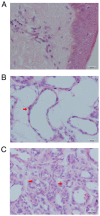Overexpression of Annexin A1 is associated with the formation of capillaries in infantile hemangioma
- PMID: 35949889
- PMCID: PMC9353882
- DOI: 10.3892/mco.2022.2566
Overexpression of Annexin A1 is associated with the formation of capillaries in infantile hemangioma
Abstract
Infantile hemangioma is a common benign tumor in infants. However, the molecular mechanism that controls the proliferation and differentiation of hemangioma is not well understood. Annexin A1 (ANX A1) is a phospholipid-binding protein involved in a variety of biological processes, including inflammation, cell proliferation and apoptosis. To explore the significance of ANX A1 in the process of proliferation or differentiation of hemangioma, proliferating and involuting hemangioma tissues were collected to detect the expression of ANX A1 using immunohistochemistry and western blotting. Normal skin tissues were used as the negative control. The results revealed that ANX A1 was upregulated in the proliferative phase of hemangioma, and its expression was decreased when the hemangioma entered the involuting phase. Additionally, in the proliferative phase, the strongest staining of ANX A1 was observed in newly born capillaries, and the staining of ANX A1 became weaker in enlarged vessels, indicating that ANX A1 plays an important role in promoting the formation of capillaries. The expression of hypoxia-inducible factor (HIF)-1α was positively associated with the expression trend of ANX A1, suggesting that the overexpression of ANX A1 may be associated with the increase of HIF-1α. In summary, the results of the present study revealed that the expression of ANX A1 was increased in proliferating hemangioma tissue, and that high expression of ANX A1 may be closely associated with the formation of capillaries in infantile hemangioma.
Keywords: Annexin A1; capillary; extracellular signal-regulated kinase 1/2; hemangioma; hypoxia-inducible factor-1α; proliferation.
Copyright: © Pan et al.
Conflict of interest statement
The authors declare that they have no competing interests.
Figures






Similar articles
-
Downregulation of Annexin A1 by short hairpin RNA inhibits the osteogenic differentiation of rat bone marrow-derived mesenchymal stem cells.Int J Mol Med. 2015 Aug;36(2):406-14. doi: 10.3892/ijmm.2015.2243. Epub 2015 Jun 11. Int J Mol Med. 2015. PMID: 26063293 Free PMC article.
-
Propranolol represses infantile hemangioma cell growth through the β2-adrenergic receptor in a HIF-1α-dependent manner.Oncol Rep. 2015 Jun;33(6):3099-107. doi: 10.3892/or.2015.3911. Epub 2015 Apr 14. Oncol Rep. 2015. PMID: 25872592
-
PKCdelta-dependent cleavage and nuclear translocation of annexin A1 by phorbol 12-myristate 13-acetate.Eur J Biochem. 2003 Oct;270(20):4089-94. doi: 10.1046/j.1432-1033.2003.03800.x. Eur J Biochem. 2003. PMID: 14519120
-
Cracking the code of Annexin A1-mediated chemoresistance.Biochem Biophys Res Commun. 2024 Sep 17;725:150202. doi: 10.1016/j.bbrc.2024.150202. Epub 2024 May 31. Biochem Biophys Res Commun. 2024. PMID: 38885563 Review.
-
Macrophage biology in the Anx-A1-/- mouse.Prostaglandins Leukot Essent Fatty Acids. 2005 Feb;72(2):95-103. doi: 10.1016/j.plefa.2004.10.008. Prostaglandins Leukot Essent Fatty Acids. 2005. PMID: 15626592 Review.
Cited by
-
Loss of Endothelial Annexin A1 Aggravates Inflammation-Induched Vascular Aging.Adv Sci (Weinh). 2024 Apr;11(15):e2307040. doi: 10.1002/advs.202307040. Epub 2024 Feb 15. Adv Sci (Weinh). 2024. PMID: 38358087 Free PMC article.
References
-
- Kanada KN, Merin MR, Munden A, Friedlander SF. A prospective study of cutaneous fifindings in newborns in the United States: Correlation with race, ethnicity, and gestational status using updated classifification and nomenclature. J Pediatr. 2012;161:240–245. doi: 10.1016/j.jpeds.2012.02.052. - DOI - PubMed
-
- Priya C, Varshini C, Biswakumar B. Case report: A rare case of infantile hemangioma, treated in a private clinic as out patient. Prim Health Care. 2019;9(321)
LinkOut - more resources
Full Text Sources
